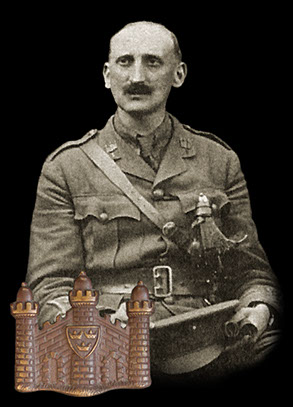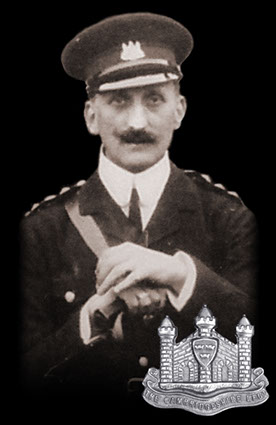Major Henry Hamilton Staton
Known as Harry, he was born in 1874 near Worksop but later moved to the Peterborough area. For most of his life he worked as a dentist and was very well known in the local community due to both this and his long-standing involvement with the local volunteer forces.
Harry was commissioned into the Cambridgeshire Regiment as a Captain in late 1912, having already spent many years in the ranks and later as a commissioned officer with the Volunteer Battalion of the Northamptonshire Regiment.
His time with the Cambs was covered in detail in an article written by one of the co-owners of this site, Robin James, for the Orders and Medal Research Society Journal. The relevant extracts from this article are duplicated below.
Extract from: Town and Gown: Heroes all: the Cambridgeshire Regiment at War part I. OMRS Journal: December 2011.
Staton obtained his commission after five years in the ranks of the Volunteer Battalion Northamptonshire Regiment; the Old Greycoats, in March 1897, and promoted then to Captain in 1902. He was educated at Deacon’s and King’s Schools, Peterborough, and articled to his uncle, a Major Payling, who acted as a father to him, and became a fully qualified dental surgeon in 1896. From 1912 to the start of the War he sat on the Peterborough City Council as a representative of the West Ward whilst also working in his uncle’s dental practice in both Peterborough and Stamford. When the Battalion embarked to France, he accompanied them as the commander of F (Whittlesey) Company. Clearly well thought of by his men he is described fondly in the regimental history:
He was always known as ‘The Master’ (the CSM was the ‘Foreman’); his age would have been justification for his remaining at home; but when his Company needed a lead, he was the first to volunteer.
Shortly after the events at St. Eloi the Battalion moved to Sanctuary Wood. As was common at the time one of the areas they occupied was named after them and was for the rest of the War known as Cam Grove. The trenches there were highly unsatisfactory, it was hard to dig amongst the tree roots and they were very wet with the bottom eight inches or so being liquid mud. Also, they were close to the enemy lines, as little as fifteen yards in places, but this did mean that they were too close to be shelled. This positive aspect of being too close to be shelled, however, brought with it another constant danger: that of snipers; and coupled with the sloping shape of the land a number of the trenches could be enfiladed from the enemy lines. Although “flying traverses” were constructed the Battalion was suffering terribly with casualties caused by snipers and it was to one of these enemy marksmen that Staton was soon to fall victim. It was 13 April. Lieut. Clayton again, noting:
When we returned, after four days in Cam Grove, [Major] Saint had done a good deal of work, but had not discovered the position of the sniper. The next morning he killed another man out behind our trench. Without a moment’s hesitation Staton dashed out to bring in the man, and whilst stooping over him was hit by the sniper. The bullet fortunately was a fraction of an inch too high, traversing and depressing the top of his skull. Staton was able to walk down to the dressing station, but his wound put an end to the active service of an officer who held the affection of his men to a remarkable degree.
It would be easy for the armchair critic at this stage to suggest that it was tactically unwise for a Company Commander to attempt to bring in one of his private soldiers but such is war, when the bonds between men become unbelievably strong and where a centimetre either way was the difference between a “Blighty one” and the ultimate sacrifice. The men commanded by Staton were only slightly older than his sons, and the burden of responsibility for officers of his age must have been almost overwhelming. He had been heard, shortly before, to be instructing his men to keep low, but as previously mentioned, the ground did not lend itself well to entrenched positions. Later that same day the sniper struck again but this time he betrayed his likely position. Industriously the men set to using all the tricks in the book, such as showing their cloth caps above the parapet, to confirm his location, and he took the bait. The men of Staton’s company were therefore able to ascertain his exact position; which was in fact a small steel ‘tree stump’, and employ their own snipers to engage his position, with good effect.
Staton, underwent surgery at Rouen hospital, then returned to England, and after a brief period of recovery was able to take up his duties again with the Regiment, though he was not to return overseas. He was to bear the mark of this day for the rest of his life, with a prominent scar running across his forehead, but he had undoubtedly been extremely lucky and was fortunate to have got off so lightly, the soldier he was attempting to recover was killed.
After his recovery, Staton was soon back with the Cambridgeshires, helping to recruit and train those destined for the 1st Battalion. Promoted to Major in August 1915, he was awarded the TD in June 1921 and retired with the rank of Major in 1924. His son, incidentally, had also commissioned into the Cambridgeshire Regiment in 1921 and their service had therefore overlapped by three years. Further post-war information on Staton is minimal; it is assumed he returned to the Peterborough area, and presumably his dental practice. He was a member of the Royal British Legion and in June of 1929 Prince George (later King George VI) visited Peterborough during its Civic Week. A correspondent followed the visit and an extract from the report in the Times of 29 June notes that:
At the town hall he inspected a guard of honour of the Peterborough branch of the British Legion, under the command of Major H.H. Staton.
The award of Member of the Most Excellent Order of the British Empire (MBE) gazetted and presented by King George V in 1937 “For political and public services in Peterborough” suggests a return to local government during the inter-war years and his award of the Defence Medal indicates service of some description during World War II. Whatever his role, such service is laudable, because in 1939 he would have been 65 years old and must surely have volunteered rather than been required to serve. He died at the age of 77 in September 1951.

Staton shortly before leaving for France, 1915.

Staton presenting a TFEM.

Harry Staton circa 1914.

This site went live on the 14th February 2015 to mark 100 years since the 1/1st Cambs went off to war.
WE WILL REMEMBER THEM
Email us: cambsregt@gmail.com
Copyright 2015, 2016, 2017, 2018, 2019 by Felix Jackson. The information and images on this site should not be reproduced without prior permission.